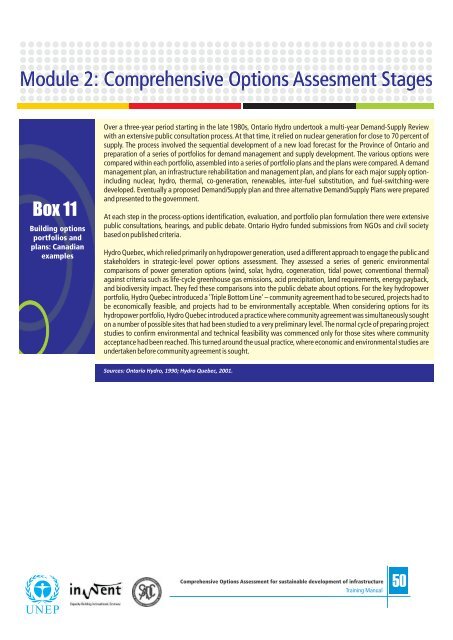Comprehensive Option Assesment - UNEP
Comprehensive Option Assesment - UNEP
Comprehensive Option Assesment - UNEP
You also want an ePaper? Increase the reach of your titles
YUMPU automatically turns print PDFs into web optimized ePapers that Google loves.
Module 2: <strong>Comprehensive</strong> <strong>Option</strong>s <strong>Assesment</strong> Stages<br />
Box 11<br />
Building options<br />
portfolios and<br />
plans: Canadian<br />
examples<br />
Over a three-year period starting in the late 1980s, Ontario Hydro undertook a multi-year Demand-Supply Review<br />
with an extensive public consultation process. At that time, it relied on nuclear generation for close to 70 percent of<br />
supply. The process involved the sequential development of a new load forecast for the Province of Ontario and<br />
preparation of a series of portfolios for demand management and supply development. The various options were<br />
compared within each portfolio, assembled into a series of portfolio plans and the plans were compared. A demand<br />
management plan, an infrastructure rehabilitation and management plan, and plans for each major supply optionincluding<br />
nuclear, hydro, thermal, co-generation, renewables, inter-fuel substitution, and fuel-switching-were<br />
developed. Eventually a proposed Demand/Supply plan and three alternative Demand/Supply Plans were prepared<br />
and presented to the government.<br />
At each step in the process-options identification, evaluation, and portfolio plan formulation there were extensive<br />
public consultations, hearings, and public debate. Ontario Hydro funded submissions from NGOs and civil society<br />
based on published criteria.<br />
Hydro Quebec, which relied primarily on hydropower generation, used a different approach to engage the public and<br />
stakeholders in strategic-level power options assessment. They assessed a series of generic environmental<br />
comparisons of power generation options (wind, solar, hydro, cogeneration, tidal power, conventional thermal)<br />
against criteria such as life-cycle greenhouse gas emissions, acid precipitation, land requirements, energy payback,<br />
and biodiversity impact. They fed these comparisons into the public debate about options. For the key hydropower<br />
portfolio, Hydro Quebec introduced a 'Triple Bottom Line' – community agreement had to be secured, projects had to<br />
be economically feasible, and projects had to be environmentally acceptable. When considering options for its<br />
hydropower portfolio, Hydro Quebec introduced a practice where community agreement was simultaneously sought<br />
on a number of possible sites that had been studied to a very preliminary level. The normal cycle of preparing project<br />
studies to confirm environmental and technical feasibility was commenced only for those sites where community<br />
acceptance had been reached. This turned around the usual practice, where economic and environmental studies are<br />
undertaken before community agreement is sought.<br />
Sources: Ontario Hydro, 1990; Hydro Quebec, 2001.<br />
<strong>Comprehensive</strong> <strong>Option</strong>s Assessment for sustainable development of infrastructure<br />
Training Manual<br />
50
















